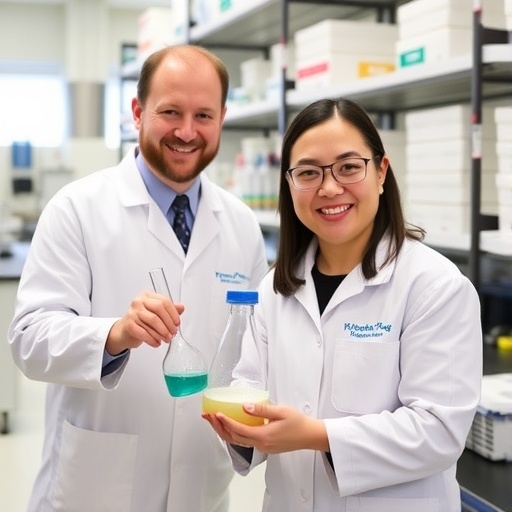
In an innovative stride within the realms of pharmaceutical research and drug design, scientists at the Southwest Research Institute (SwRI) have harnessed the capabilities of artificial intelligence to craft a new tool aimed at revolutionizing how chemical compounds are analyzed and developed. Known as the Generative Approaches for Molecular Encodings (GAMES), this large language model (LLM) is specifically designed to streamline the generation of Simplified Molecular Input Line Entry System (SMILES) strings. These strings serve as a critical text-based representation of molecular structures, facilitating easy storage, retrieval, and modeling in myriad scientific contexts.
The significance of this development cannot be overstated. Traditional methods of drug design often involve an immense amount of trial and error, compounded by the intricate and time-consuming processes of molecular validation and comparison. By training the GAMES model to produce valid SMILES strings from a diverse array of molecular structures, the researchers at SwRI have introduced a systematic approach to building extensive databases and networks of molecules sat for informed analysis by artificial intelligence. This opens up new avenues for efficiency in drug discovery, allowing researchers to identify promising compounds faster than ever before.
Dr. Jonathan Bohmann, the lead developer of SwRI’s Rhodium™ molecular docking software, articulated the transformative potential of such technological advancements. He pointed out that the integration of the GAMES model into existing workflows allows for a generalized and more expedited method of exploring large chemical libraries for novel drug candidates. This is pivotal in an industry where speed and accuracy are paramount, especially given the competitive nature of pharmaceutical development where the journey from discovery to market can span over a decade.
.adsslot_49mTt8EIXD{width:728px !important;height:90px !important;}
@media(max-width:1199px){ .adsslot_49mTt8EIXD{width:468px !important;height:60px !important;}
}
@media(max-width:767px){ .adsslot_49mTt8EIXD{width:320px !important;height:50px !important;}
}
ADVERTISEMENT
What sets GAMES apart from other models is its training methodology, which involved a meticulous focus on carbon-based molecules and a suite of reference compounds to ensure the accuracy of the SMILES strings produced. As Dr. Bohmann aptly noted, LLMs allow researchers to approach molecular data in a manner akin to handling natural language, thus leveraging the text-based integrity inherent to SMILES strings without necessitating convoluted transformations into abstracts that could obscure valuable information.
Moreover, the researchers’ use of advanced techniques like Low-Rank Adaptation (LoRA) and Quantized LoRA (QLoRA), which are designed to fine-tune LLMs with efficiency, further enhances the model’s performance. This is especially critical, given the vast computational power typically required to process complex molecular data. By reducing the hardware and energy demands associated with running their models, the team is not only ensuring sustainability but also paving the way for broader applications across different domains beyond drug discovery.
The implications of GAMES reach beyond mere efficiency; they touch upon the qualitative aspects of drug development. With GAMES, researchers envision a future where the accurate generation of SMILES could radically reshape how drug candidates are evaluated for “drug-likeness,” a term referring to a set of characteristics that predict the likelihood of a compound receiving regulatory approval and being effective in clinical settings. By leveraging structured datasets and employing rigorous training techniques, the SwRI team has successfully heightened the number of validated SMILES strings while concurrently minimizing errors from invalid outputs.
As GAMES continues to evolve, the exploration of chemical landscapes systematically through rigorous testing will be a primary focus. Both Dr. Bohmann and his colleague, Research Scientist Daniel Hinojosa, are intending to seek further funding to expand the project’s scope, aiming for enhancements that could substantially benefit the drug discovery domain. In its nascent stages, the GAMES initiative has already begun to influence ongoing research at SwRI, showcasing the immediate practical impact of such cutting-edge development.
Funding for GAMES was made possible through the SwRI Internal Research and Development Program, aligning perfectly with SwRI’s mission of continually investing in future technologies. Over the past year, the institute allocated upwards of $11 million to expand its scientific repertoire and enhance its status as a leader in research and technology, all while fostering the professional growth of its talented workforce. This proactive approach to innovation signifies an unwavering commitment to pushing the boundaries of what is currently achievable in scientific research.
In conclusion, the creation of the GAMES model stands as a testament to the efficacy of integrating machine learning techniques into scientific inquiry. As it becomes more entrenched in the drug development landscape, it is poised to not only accelerate the identification of new therapeutic agents but also substantially augment the precision and adaptability with which molecular properties are assessed. This evolution heralds a new chapter in the quest for effective pharmacological solutions, establishing an essential bridge between artificial intelligence and biochemistry—a relationship undoubtedly destined for further exploration and growth.
Subject of Research: Development of a large language model for drug discovery
Article Title: Southwest Research Institute Develops AI Model to Accelerate Drug Design
News Publication Date: August 14, 2025
Web References: https://www.swri.org/markets/biomedical-health/pharmaceutical-development/drug-discovery/structure-based-virtual-screening
References: Funding provided by SwRI Internal Research and Development Program
Image Credits: Southwest Research Institute
Keywords
Drug development, Generative AI, Machine learning, Medical technology
Tags: AI-driven compound analysisartificial intelligence in pharmaceuticalsdrug discovery accelerationefficiency in drug developmentGAMES large language modelinnovative drug design methodsmolecular encoding techniquesmolecular structure representationRhodium molecular docking softwareSimplified Molecular Input Line Entry SystemSwRI pharmaceutical researchsystematic approaches in chemistry





